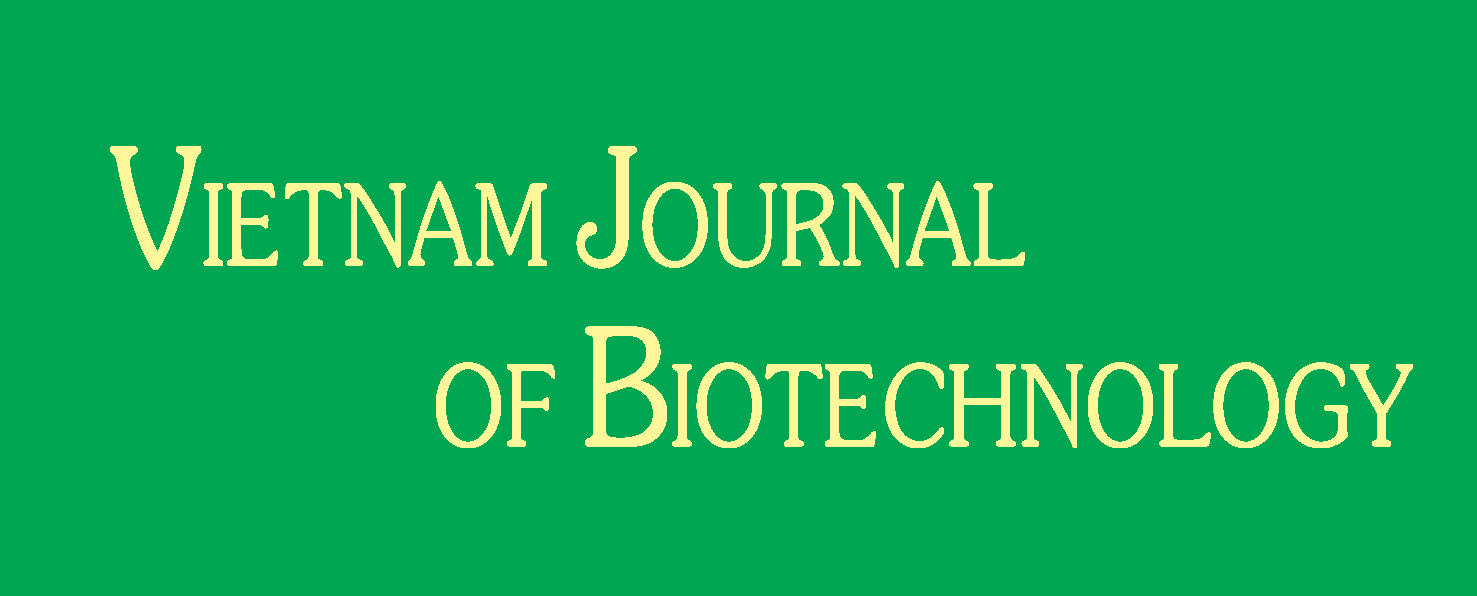Investigating the phytochemical production and antioxidant activity in four plant species belonging to the asteraceae family
Author affiliations
DOI:
https://doi.org/10.15625/vjbt-21592Keywords:
Antioxidant, Asteraceae, flavonoid, free radical scavenging activity, phenolic, secondary metabolitesAbstract
Vietnam has a rich and profound traditional medicine system that is widely used today. Medicinal plants are used to treat colds, coughs, bone and joint diseases, digestion, respiratory diseases, etc. In this study, leaves of Artemisia vulgaris, Taraxacum officinale, Blumea balsamifera, and flowers of Xerochrysum bracteatum from the Asteraceae family were selected to determine the antioxidant capacity and relationship with the active ingredients in the plants. The methanolic extracts were screened for chemical compositions via the total phenolic content (TPC) assay, the total flavonoid content (TFC) assay, and DPPH radical scavenging activity. The highest radical scavenging activity was observed in the flowers of X. bracteatum (IC50 = 0.061 mg/mL), followed by the leaves of Taraxacum (IC50 = 0.313 mg/mL), A. vulgaris (IC50 = 1.367 mg/mL), and B. balsamifera (IC50 = 1.4502 mg/mL). The TPC of the studied plants ranged from 19.98 ± 1.355 to 195.78 ± 42.518 mgGAE/g extract, while the TFC ranged from 60.31 ± 1.725 to 339.14 ± 26.299 mgQE/g extract. The highest TPC and TFC were recorded in the methanol extract of X. bracteatum. The strongly negative correlation between the TPC and TFC and the IC50 values (R2 = -0.78, R2 = -0.76) suggests that TFC and TPC could strongly contribute to the antioxidant activity of these plants. These results not only highlight the relevance of these plants in traditional medicine but also scientifically validate their use, particularly in the context of their antioxidant properties. The study underscores the close relationship between the traditional use of these plants and their scientifically observed effects, reinforcing the value of folk remedies.
Downloads
References
Akinyede KA, Cupido CN, Hughes GD, Oguntibeju OO, Ekpo OE (2021) Medicinal properties and in vitro biological activities of selected Helichrysum species from South Africa: A Review. Plants 10(8): 1566.
Ashok PK, Upadhyaya K (2013) Evaluation of analgesic and anti-inflammatory activities of aerial parts of Artemisia vulgaris L. in experimental animal models. J. of Bio. Active Prod. from Nature 3(1): 101–105. https://doi.org/10.1080/22311866.2013.782761.
Chaachouay N, Zidane L (2024) Plant-Derived Natural Products: a source for drug discovery and development. Drugs and Drug Candidates 3(1): 184–207. https://doi.org/10.3390/ddc3010011.
Dai L, Cai S, Chu D, Pang R, Deng J, Zheng X, Dai W (2023) Identification of chemical constituents in Blumea balsamifera using UPLC–Q–Orbitrap HRMS and evaluation of their antioxidant activities. Molecules 28(11): 4504. https://doi.org/10.3390/molecules28114504.
Ergün F (2021) Determination of phytochemicals and antioxidant capacity of edible dandelion plant (Taraxacum officinale) collected from Kirşehir region. Üniversitesi Akademik Veri Yönetim Sistemi. https://www.cabidigitallibrary.org/doi/pdf/10.5555/20220174035.
Fan M, Zhang X, Song H, Zhang Y (2023) Dandelion (Taraxacum Genus): A review of chemical constituents and pharmacological effects. Molecules 28(13): 5022. https://doi.org/10.3390/molecules28135022.
Garcia-Oliveira P, Barral M, Carpena M, Gullón P, Fraga-Corral M, Otero P, Prieto MA, Simal-Gandara J (2021) Traditional plants from Asteraceae family as potential candidates for functional food industry. Food & Function 12(7): 2850–2873. https://doi.org/10.1039/d0fo03433a.
Jalili C, Taghadosi M, Pazhouhi M, Bahrehmand F, Miraghaee SS, Pourmand D, Rashidi I (2020) An overview of therapeutic potentials of Taraxacum officinale (dandelion): a traditionally valuable herb with a rich historical background. World Cancer Research Journal 7: e1679. https://www.wcrj.net/article/1679.
Liu N, Song M, Wang N, Wang Y, Wang R, An X, Qi J (2020) The effects of solid-state fermentation on the content, composition, and in vitro antioxidant activity of flavonoids from dandelion. PLoS ONE 15(9) : e0239076. https://doi.org/10.1371/journal.pone.0239076.
Najar B, Cervelli C, Ferri B, Cioni P, Pistelli L (2019) Essential oils and volatile emission of eight South African species of Helichrysum grown in uniform environmental conditions. South African Journal of Botany 124: 178–187. https://doi.org/10.1016/j.sajb.2019.05.015.
Nga MTP, Linh TK, Tra NPC, Linh HTP (2024) Strategies to enhance the production of biomass and natural antioxidants of Cichorium intybus L. hairy roots by using nanoparticle elicitors. Vietnam Journal of Biotechnology 22(2): 305–317. https://doi.org/10.15625/vjbt-19545.
Pandey KB, Rizvi SI (2009) Plant polyphenols as dietary antioxidants in human health and disease. Oxidative Medicine and Cellular Longevity 2(5): 270–278. https://doi.org/10.4161/oxim.2.5.9498.
Pang Y, Wang D, Fan Z, Chen X, Yu F, Hu X, Wang K, Yuan L (2014) Blumea balsamifera-A phytochemical and pharmacological review. Molecules 19(7): 9453–9477. https://doi.org/10.3390/molecules19079453.
Phuyal N, Jha PK, Raturi PP, Rajbhandary S (2020) Total phenolic, flavonoid contents, and antioxidant activities of fruit, seed, and bark extracts of Zanthoxylum Armatum DC. The Scientific World Journal 2020: 1–7. https://doi.org/10.1155/2020/8780704.
Rawati S, Ginting B, Maulana I, Yahya M, Saidi N, Murniana M, Hasballah K (2023) Phytochemical, antioxidant, and cytotoxicity screenings of n-hexane extract from Blumea balsamifera L. leaves. Research Journal of Pharmacy and Technology 16(4): 1664–1668. https://doi.org/10.52711/0974-360x.2023.00272.
Rolnik A, Olas B (2021) The plants of the Asteraceae family as agents in the protection of human health. International Journal of Molecular Sciences 22(6): 3009. https://doi.org/10.3390/ijms22063009.
Rolnik A, Soluch A, Kowalska I, Olas B (2021) Antioxidant and hemostatic properties of preparations from Asteraceae family and their chemical composition - Comparative studies. Biomedicine & Pharmacotherapy 142: 111982. https://doi.org/10.1016/j.biopha.2021.111982.
Schütz K, Carle R, Schieber A (2006) Taraxacum-A review on its phytochemical and pharmacological profile. Journal of Ethnopharmacology 107(3): 313–323. https://doi.org/10.1016/j.jep.2006.07.021.
Seca AML, Pinto DCGA (2019) Biological potential and medical use of secondary metabolites. Medicines 6(2): 66. https://doi.org/10.3390/medicines6020066.
Sharma KR, Adhikari S (2023) Phytochemical analysis and biological activities of Artemisia vulgaris grown in different altitudes of Nepal. International Journal of Food Properties 26(1): 414–427. https://doi.org/10.1080/10942912.2023.2166954.
Singleton VL, Orthofer R, Lamuela-Raventós RM (1999) Analysis of total phenols and other oxidation substrates and antioxidants by means of folin-ciocalteu reagent. Methods in enzymology 152–178. https://doi.org/10.1016/s0076-6879(99)99017-1.
Thangjam NM, Taijong J, Kumar A (2020) Phytochemical and pharmacological activities of methanol extract of Artemisia vulgaris L. leaves. Clinical Phytoscience 6(1): 72. https://doi.org/10.1186/s40816-020-00214-8.
Widhiantara IG, Jawi IM (2021) Phytochemical composition and health properties of Sembung plant (Blumea balsamifera): A review. Veterinary World 14(5): 1185–1196. https://doi.org/10.14202/vetworld.2021.1185-1196.
Yan Q, Xing Q, Liu Z, Zou Y, Liu X, Xia H (2024) The phytochemical and pharmacological profile of dandelion. Biomedicine & Pharmacotherapy 179: 117334. https://doi.org/10.1016/j.biopha.2024.117334.







